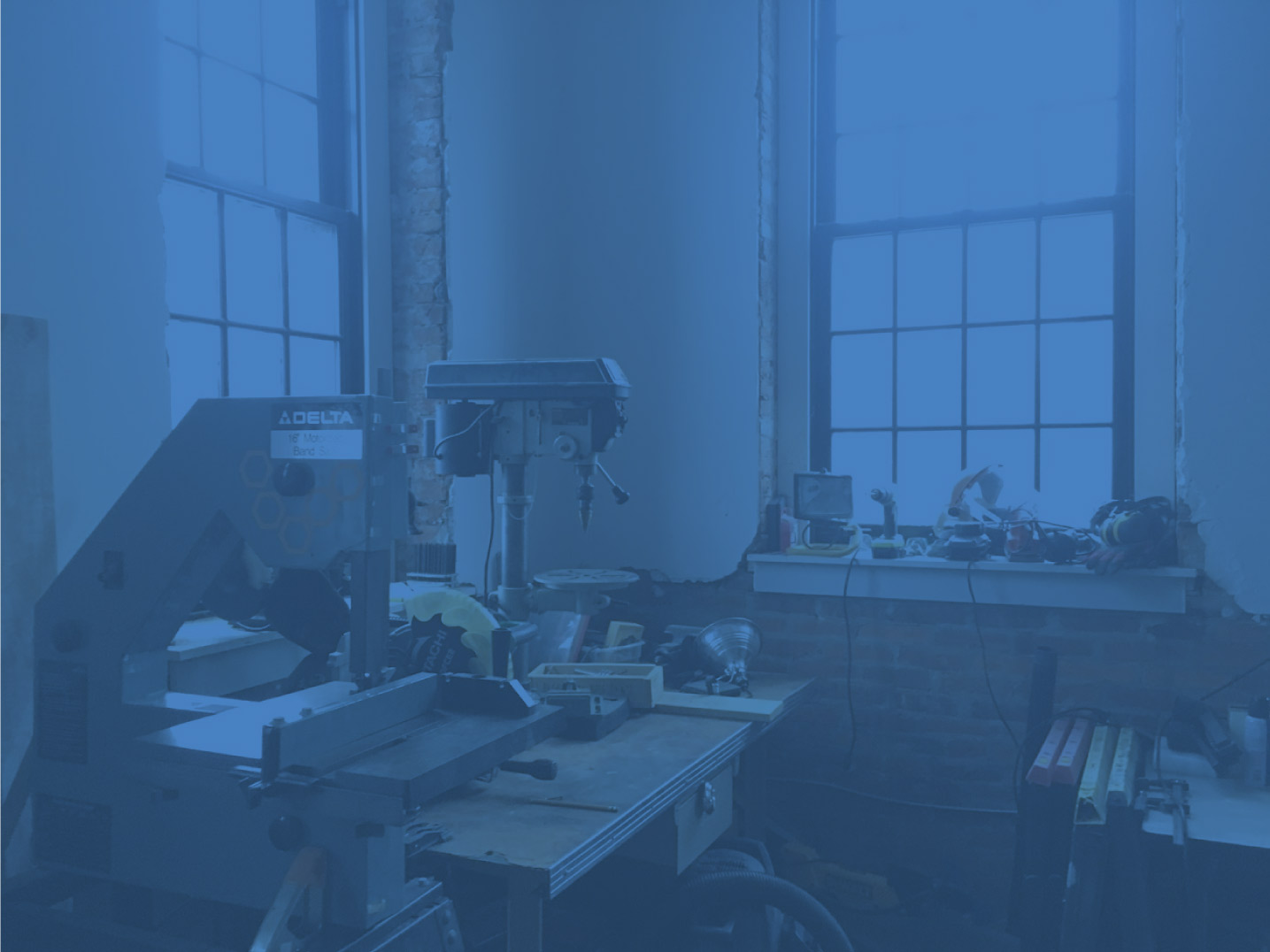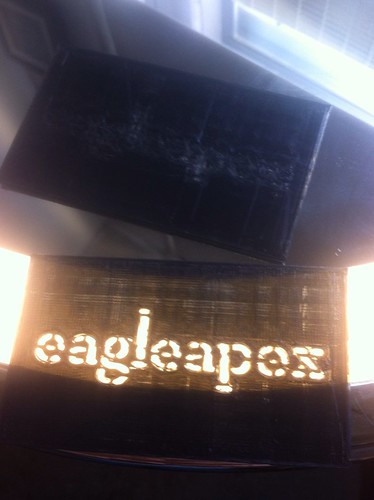What is art? To me it has always meant indirect communication–the implied conveyance of ideas through conventions of shared culture. Anything is fair game for a medium, and anything can be a potential message; thus art is infinite in both dimensions.
Continue reading “How I Made the Art Hackathon Image”
Crafty Computer …

After visiting The Hacktory’s “Soft Circuit” event, PJ and I were inspired to take a stab at making some micro-controller circuits using alternative, “high/low tech” approaches. PJ made an MCU circuit using conductive paint (has potential, but needs some tweaks). I opted to try a circuit board using metal leaf. That happened to work on the first shot — although careful scrutiny of the picture on the left suggests there was some luck involved (there are holes in the circuit that come dangerously close to wrecking it). Continue reading “Crafty Computer …”
Saturday Open House
We’re doing an additional open house every week now. If you can’t make it on Wednesdays, or if you’d like an additional day to come and check us out, we’ll be there every Saturday starting at 2 PM.
Stop by and check out our 3D printer, our plethora of games, or come just to hang out, and/or work on your own project ideas.
Feb 22nd: Meet the Developers of Apostrophe Now!
Apostrophe Now! — based out of Philadelphia and developed by P’unk Ave — is “a content management system designed for maximum flexibility with a minimal learning curve. The interface is ergonomic, all content-editing is performed in-context.”
Do you have or are you building a website, but you are looking for alternatives to WordPress, Django and other CMS engines? Apostrophe may be right for you!
Come meet Geoff DiMasi and Tom Boutell, two of the lead developers, and find out all the nitty gritty about Apostrophe. They’ll give an overview of the system, design goals, and features, and they’ll also dive into the code to show us how it’s all put together. Geoff and Tom will also talk about other things Philadelphia (the founding of P’unk Ave, the founding of Indy Hall, and the founding of Ignite Philly).
You won’t find this info on Youtube or Vimeo. Come on down to your favorite hackerspace to learn all about Apostrophe and an awesome Philadelphia success story.
Hive76
Wednesday, February 22nd, 7:30 pm
915 Spring Garden, Suite 519
You can 3D print anything, including business cards
Sure they took 30 min to print two, but if my time is worthless (now that I’m unemployed) then they are nearly free!
Continue reading “You can 3D print anything, including business cards”
P3D: 3D Model Viewer in the Browser, No Extensions Required
P3D.in is a new beta service (currently free, prolly will change) for rendering 3D models in the web browser, no flash or plugins required. I guess it works via HTML5?
They only take .obj files at the moment (which you can export to from Blender). It’d be much much more useful if they automatically imported STL files, and all of Thingiverse, among other sites. I’ve logged a bug report and feature request along these lines.
Here’s a yoda head converted to .obj and imported and hosted by P3D in their demo iframe. pretty cool. (NOTE: I guess it needs a while to load in the browser, apparently. So if it’s not showing up yet in your browser, give it a minute).
CONTROLS:
Left click and drag – rotate
middle click and drag – zoom
Right click and drag – translate
NASA: The Blue Marble, 2012 Edition


NASA today released a crazy high-res reconstructed photograph of the world, 61 megapixels (8,000 x 8,000)… we can finally replace the one from Apollo 17 from 1972.
A ‘Blue Marble’ image of the Earth taken from the VIIRS instrument aboard NASA’s most recently launched Earth-observing satellite – Suomi NPP. This composite image uses a number of swaths of the Earth’s surface taken on January 4, 2012. The NPP satellite was renamed ‘Suomi NPP’ on January 24, 2012 to honor the late Verner E. Suomi of the University of Wisconsin.
Suomi NPP is NASA’s next Earth-observing research satellite. It is the first of a new generation of satellites that will observe many facets of our changing Earth.
Suomi NPP is carrying five instruments on board. The biggest and most important instrument is The Visible/Infrared Imager Radiometer Suite or VIIRS.
Image Credit: NASA/NOAA/GSFC/Suomi NPP/VIIRS/Norman Kuring
Never Buy a Dust Cover Again

Here at Hive76, my desk sits right next to the wood working station. Normally, this isn’t an issue because my computer uses passive heat management, so there is no risk of getting dust clogged up in the fans. But I recently bought a new printer and want to keep it nice and clean. I initially thought of buying a dust cover, but serendipitously completely forgot to even look for them before I left the store. So, necessity being the mother of invention that it is, I was stuck in the space, not wanting to hop back in the car for a silly little dust cover, when I realized that I had a useless cardboard box that I was about to discard that was almost the exact dimensions of the printer itself. Duh! The box it came in! I cut one side off of the box, taped the corners down, left the hole from the missing flap for the wires coming out of the back of the printer, and voila! A free dust cover. I suppose if the color ever bothers me I can just spray paint it a solid color. This solution is actually better than a real cover because now I can stack papers and other lite objects on top when the printer isn’t in use and not have to worry about them sliding or rolling off because of the somewhat round top of the printer.


Blender used to Render cover of Nature Chemistry
Christopher Wilmer from Northwestern University just got published in a leading chemistry journal, Nature Chemistry. Congrats Christopher! To convey his scientific findings to a broader audience, he designed this artwork that made it on the cover of the journal. Open source science and art FTW…
Check it out!
http://www.blendernation.com/2012/01/27/blender-used-to-make-cover-art-for-nature-chemistry/
And here’s the Nature Chemistry paper.
Cover art Summary:
Randall Snurr and co-workers describe a computational approach for simulating every possible metal-organic framework (MOF) that can be built from a given set of building blocks (metal clusters and organic ligands) — represented conceptually on the cover using Tinkertoys. Some of the properties of MOFs can also be simulated to uncover structure–property relationships or materials suitable for specific applications. The MOF shown on the cover was identified for its methane storage capacity — a property that was subsequently confirmed experimentally.
Paper Abstract:
Metal–organic frameworks (MOFs) are porous materials constructed from modular molecular building blocks, typically metal clusters and organic linkers. These can, in principle, be assembled to form an almost unlimited number of MOFs, yet materials reported to date represent only a tiny fraction of the possible combinations. Here, we demonstrate a computational approach to generate all conceivable MOFs from a given chemical library of building blocks (based on the structures of known MOFs) and rapidly screen them to find the best candidates for a specific application. From a library of 102 building blocks we generated 137,953 hypothetical MOFs and for each one calculated the pore-size distribution, surface area and methane-storage capacity. We identified over 300 MOFs with a predicted methane-storage capacity better than that of any known material, and this approach also revealed structure–property relationships. Methyl-functionalized MOFs were frequently top performers, so we selected one such promising MOF and experimentally confirmed its predicted capacity.
Art Hack Day in Brooklyn
The MAKE blog recently posted a notice of an event being held this weekend–Art Hack Day–that I find very intriguing. I’ve been bandying about an similar idea, in part inspired by the Bravo Channel’s reality TV series Work of Art. The show has the typical “Top XYZ” format of elimination challenges. What strikes me about the show is that their work space looks very much like a hackerspace, and once the artists settle in to the work format, they start producing some extremely intriguing pieces.
In a lot of ways, the artist’s studio and hackerspaces are very similar; indeed, we here at Hive76 have made a former artist’s studio as our fire-retardant-home-away-from-home here at 915 Studios. So with that in mind, we are putting together a similar event to the Art Hack Day. We would like to make it an open build session with recycled materials. Stay tuned for the full details in an upcoming blog post (honestly, I will write it, really, I will).




